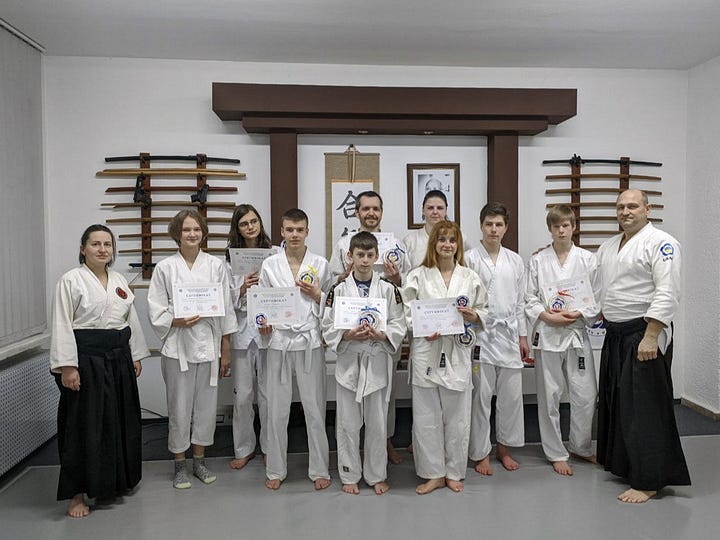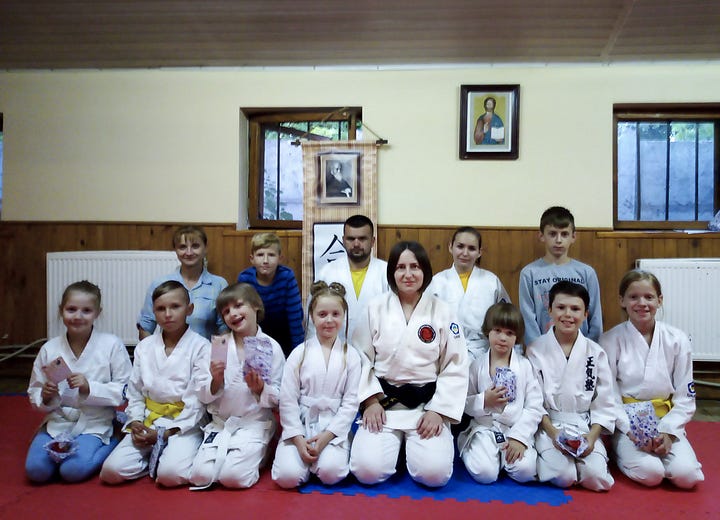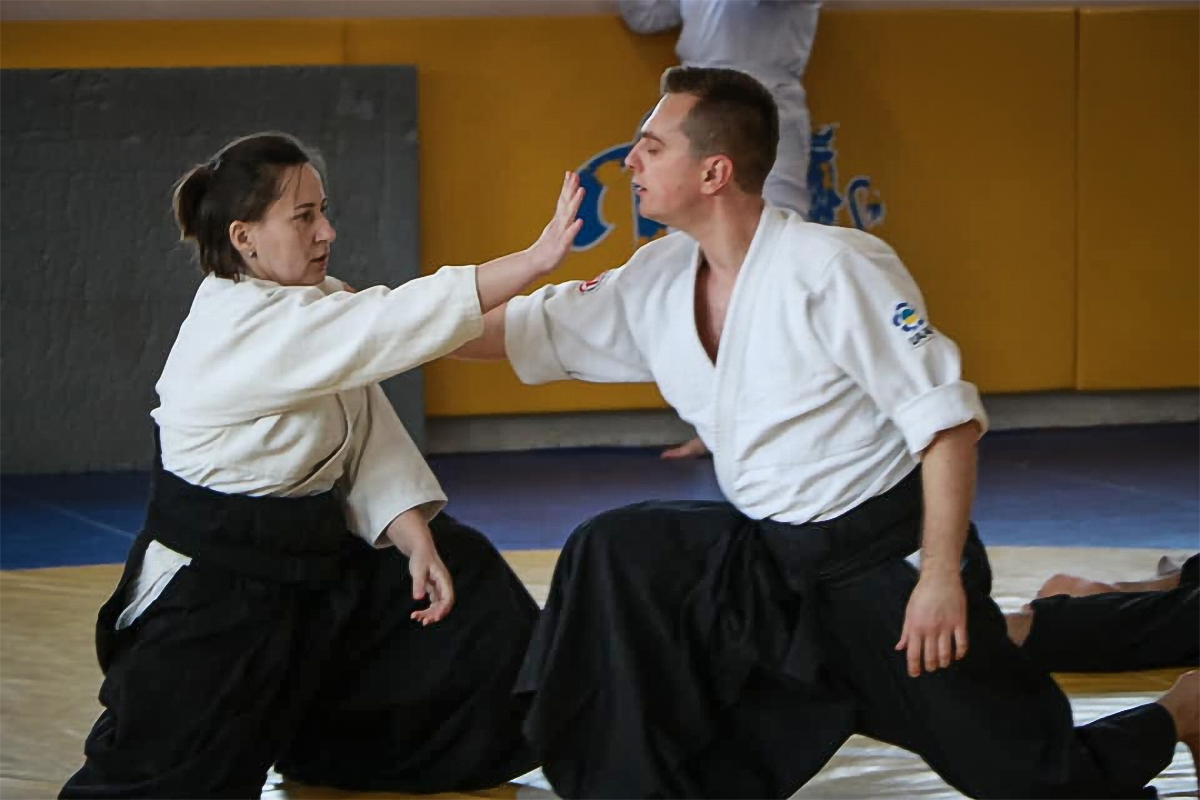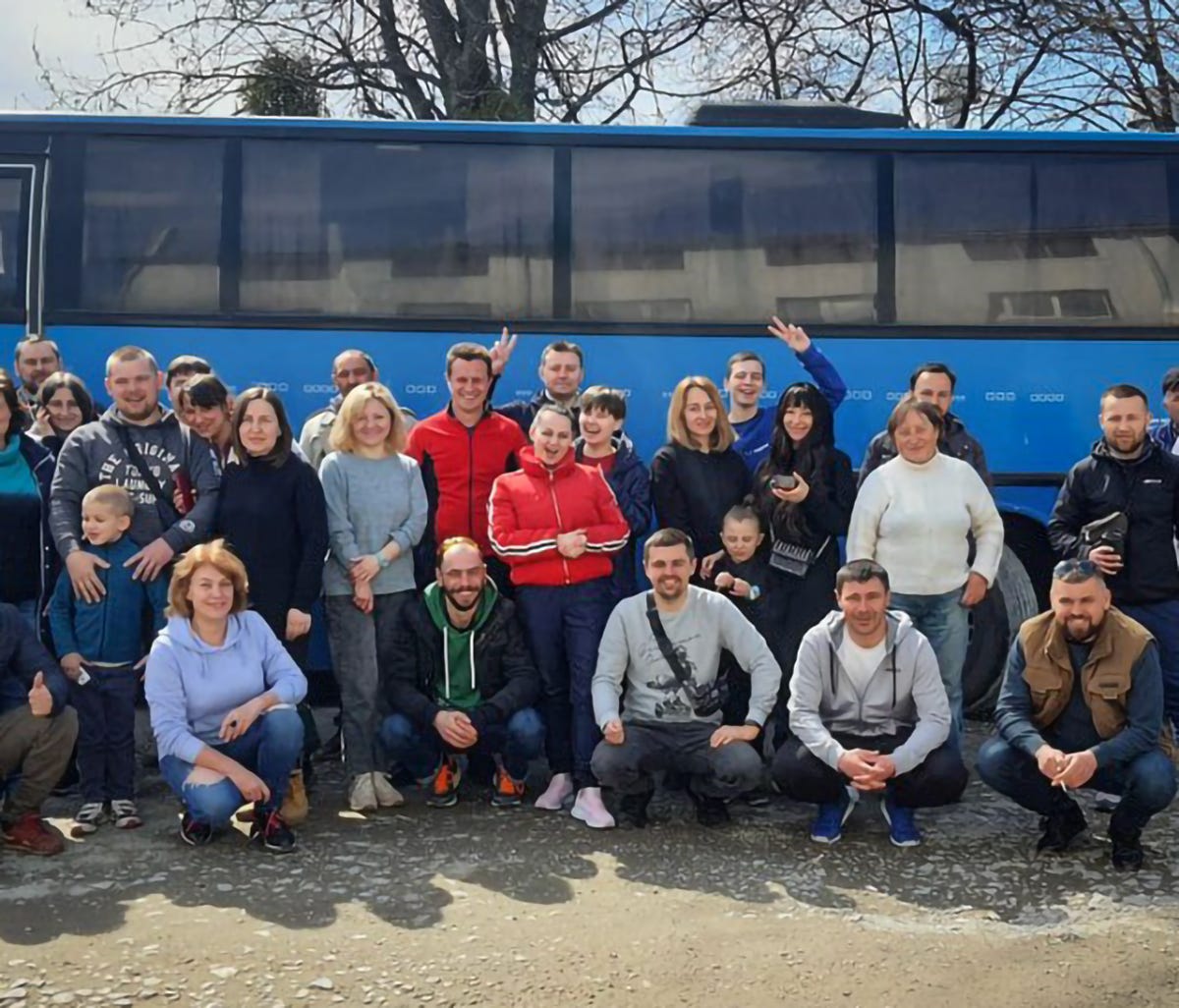The children's games that became survival skills. Part 1.
How war taught a Ukrainian instructor what aikido exercises actually prepare you for
This story emerges from conversations between Ukrainian aikido instructor Oksana Kozakevych and Saša Dokiai from Aikicraft. Rather than extracting her experience, we've collaborated as equal partners—she leads the narrative, I provide writing support and platform. What follows is her insight into what war taught about aikido that peaceful practice never could.
TL;DR: Oksana thought she was teaching "children's games" until war forced her to question everything about her art. What she discovered about the true purpose of aikido training will change how you see every roll, fall, and crawling exercise.
When training felt like play
For ten years, I watched students crawl under imaginary bridges, roll across tatami mats, and jump over their training partners like children at recess. In my two dojos in Lviv, these exercises were as routine as warm-ups—part of the foundation my first sensei insisted would "improve physical preparation and endurance."
I started aikido in 2014 as an adult in a group of adults, but even we did these movements. Crawling exercises. Rolling in every direction. Learning to fall without fear, to move low and quiet, to navigate obstacles with your whole body. My sensei treated them seriously, but to most observers, they looked like games.


The students seemed to understand this intuitively. The children especially—they'd giggle as they slithered under their partners' extended arms, race to see who could roll the farthest, compete to jump the highest over a crouched classmate. Even the adults would smile during these drills, the tension of learning complex techniques giving way to something more playful, more natural.
"These are the basics," I'd tell new students as they fumbled through their first attempts at forward rolls. "Foundation for more complex movements." It was what my teacher had told me, what the curriculum demanded, what made sense in the progression from white belt to black belt.
By 2022, I had reached 2nd dan and was teaching regularly. My groups were mixed—adults and teenagers training together, each working at their own pace through the ranks. Some would advance quickly, drawn to the elegant throws and joint locks that make aikido recognizable. Others preferred these foundational movements, finding something satisfying in the simplicity of a perfect roll or the challenge of moving silently across the mat.
The dojo felt alive with this energy. Students helping each other, laughing at mistakes, celebrating small breakthroughs. We had our routines, our rhythms, our shared understanding of what we were building together. The crawling and rolling were just part of the landscape—necessary, beneficial, but ultimately preparation for the "real" aikido that would come later.
I had no idea we were already doing the real thing.
When everything familiar disappeared
February 24, 2022 changed everything overnight.
All training stopped. Lviv was a rear area—not the frontlines where the worst fighting happened—but even here, air raid sirens wailed and shells sometimes fell. Any facility that couldn't evacuate people to bomb shelters within minutes was forced to close.
The sports halls that remained open served more urgent needs. Schools became shelters for families fleeing combat zones. Gymnasiums turned into distribution centers for humanitarian aid. The spaces where we had practiced harmony and balance now housed people carrying whatever they could grab when the bombing started.
I lost half my students in those first weeks. Some evacuated with their families, scattering across Europe—one to Poland, others further west. Parents sent children to relatives abroad, planning to follow once they could arrange their affairs. My student with third kyu came to class in January 2022 and said, "I'll probably stop training because I won't be able to continue." He'd been mobilized. I still see him sometimes on social media, somewhere in uniform, still serving.
The city filled with strangers carrying trauma. Around the train station, crowds of people moved with the particular exhaustion of those who'd left everything behind. You could see it in their clothes—whatever they happened to be wearing when the shelling started, sometimes with a medic's jacket thrown over civilian clothes, evidence of how suddenly they'd been forced to run.
I found myself questioning everything I'd spent a decade building. The techniques, the philosophy, the patient progression through ranks—what did any of it matter when people needed food, shelter, safety? When the skills that actually kept you alive were medical first aid and knowing evacuation routes?
The dojos felt like relics from a different world, one where the greatest challenge was learning to fall gracefully rather than avoiding real bullets.
But somewhere in that chaos, something wouldn't let me abandon what we'd built together.
The question that almost ended everything
"I actually thought that probably I would start doing something else entirely."
That thought kept returning in those first chaotic weeks. Everything I'd spent years building suddenly felt disconnected from the world around us. What was the point of practicing harmonious movement when people were fleeing for their lives?
Looking at my empty dojo, I wondered if I was clinging to something that no longer mattered. The hall we used for training had been converted into a warehouse for humanitarian aid. Our tatami mats sat unused while the space filled with supplies for people who'd lost everything.
The practical needs seemed so much more urgent. In Lviv, the only real activity was volunteering—helping coordinate evacuations, distributing aid, answering phones for people desperate to flee combat zones. That work felt immediately useful.
Aikido felt like a luxury from peacetime.
I had promised my students I wouldn't close the dojo, but standing surrounded by boxes meant for refugees, the promise felt naive. How could I justify spending time on martial arts practice when people needed medical aid and evacuation coordination?
Maybe it was time to let go of aikido and commit fully to work that clearly mattered.
But something stopped me from walking away completely.
Stepping into the unknown
Three months into the war, I made a decision that would change everything I thought I knew about aikido.
I kept my promise to my students. Despite the storage boxes and the uncertainty, I found a way to continue training. The sports hall next to our usual space had a playground in the courtyard. When the weather was good, I'd carry the tatami mats outside and we'd practice under the open sky.
It felt strange at first—rolling and throwing on a children's playground while air raid sirens occasionally pierced the afternoon quiet. But the students who remained were committed. Parents wrote to me saying they'd return from abroad to continue training. Children who'd been sent to relatives planned to come back. The art mattered to them in ways I was only beginning to understand.
Meanwhile, I threw myself into the volunteer work. For six months, from April through autumn, I spent my days coordinating evacuations from dangerous territories. People would call our volunteer center in desperate situations—families trapped in frontline areas, elderly residents unable to flee on their own, civilians caught in zones where Russian forces were advancing.
I'd take their calls, gather information about safe routes, connect them with other volunteers, help coordinate transportation to safer areas. The work was immediate and necessary. Lives depended on getting the information right, on staying calm under pressure, on making quick decisions when situations changed rapidly.
But something else was happening during those months. I'd started taking courses I never thought I'd need—tactical medicine, military preparation. Two different schools, two different approaches. The first was basic, almost gentle. The second was taught by actual veterans who'd returned from the frontlines, and it was serious in ways that made everything else feel like preparation.
In these courses, we learned to fall quickly and quietly. We learned to crawl undetected across open ground. We learned to move through obstacles without making noise. And slowly, a recognition began to dawn.
In Part 2, you'll read about: The moment when Oksana realized the "children's games" weren't preparation for martial arts, but for survival itself. How tactical training revealed what aikido was actually teaching, and why the art's philosophy proved more practical than any sport martial art when everything was on the line.
Know someone whose voice should be heard?
Share their story with us: 👉 https://aikicraft.substack.com/p/european-aikido-voices






